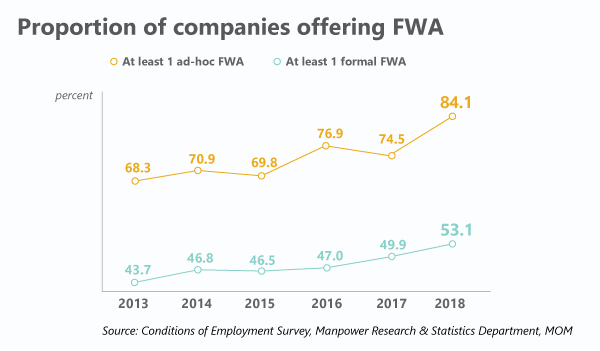A More Flexible Singapore!

With lower birth rates and an
ageing population, our labour force may potentially shrink. It becomes vital to retain and attract talents of all ages. For example, employees with family responsibilities and older workers would typically require part-time or other forms of flexibility.
To adapt to the changing employment landscape and employees’ needs, providing flexible work arrangements can be a solution to attract and retain talents across ages.
What is flexible work arrangement (FWA)?
For those who don’t know what FWA is, it’s a work arrangement that deviates from your typical 9-5 job in order to give employees flexibility. This arrangement is intended to benefit both employees and employers.
For employees, they gain the opportunity to better balance their work and personal lives or other commitments, and for employers, they gain the opportunity to better retain talent and improve workplace satisfaction.
While FWA may appear to be a recent workplace practice, it has actually been around for quite some time. One form of it, called flexi-time, can be traced back to Germany in 1967, where employees were allowed to choose their start and knock-off time to work around long commutes to and from workplaces. Soon after, Switzerland followed suit and introduced flexi-time as a way to appeal to women with family responsibilities.
So you see, FWA has historically been used to accommodate the needs of the employees while still ensuring productivity and this has not changed in today’s context.
In fact, companies in Singapore have been progressively adopting FWAs to grant their employees flexibility. Compared to 5 years ago, more companies are offering at least 1 formal FWA and/or 1 ad-hoc FWA.

Though it’s great that companies are offering FWAs to their employees, efforts would be nought if employees do not utilise FWAs.
So how can FWAs be encouraged in workplaces?
According to our
Conditions of Employment 2018 Report, there are three ways that can encourage your staff to take up FWA:
| | | It is important to have a request system in place for employees to manage their FWA requests. It can be done through formal or informal modes such as Whatsapp, emails, forms, or even verbally. |
|---|
| |
2. | Providing training to supervisors and/or employees on FWA |
|---|
| | | For employees, this will create awareness of what exactly FWA is, what are the various FWAs that their companies offer, and how FWAs can be utilised in a responsible manner. For supervisors, trainings can equip them with the expertise to objectively assess the suitability of requested FWA vis-à-vis employees’ needs, manage and ensure productivity is not neglected. |
|---|
| |
3. | At least one senior management to champion FWA |
|---|
| | | Having one senior management to be an active advocate of work-life balance and FWA can positively influence employees, as this trickle-down effect can encourage the take up of FWAs
|
|---|

Improved morale, workplace satisfaction and better work-life balance while increasing productivity at the same time are just some of the benefits of FWA.
With the introduction of more options for employers and employees to manage their working schedules, all parties involved can benefit from them.
Released on: 28 February 2019